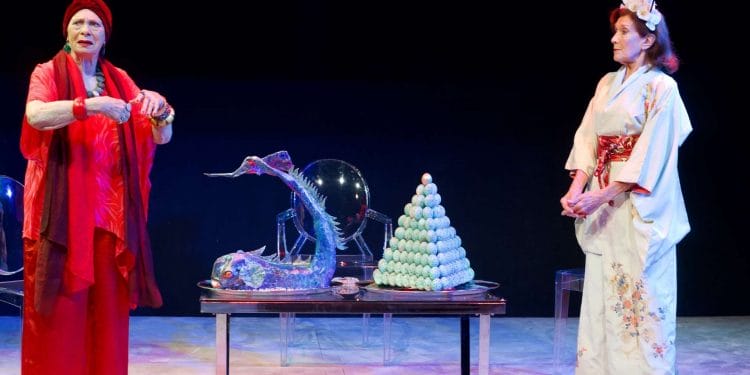 When a revival of a classic production bills itself as ‘rarely performed’ you can usually hazard a good guess at the reason it’s not been seen more often. Tennessee Williams’ The Milk Train Doesn’t Stop Here Anymore is one such example; panned by critics on its first Broadway outing in 1963, with a rewritten production closing after only five performances the following year.
When a revival of a classic production bills itself as ‘rarely performed’ you can usually hazard a good guess at the reason it’s not been seen more often. Tennessee Williams’ The Milk Train Doesn’t Stop Here Anymore is one such example; panned by critics on its first Broadway outing in 1963, with a rewritten production closing after only five performances the following year.
Not even powerhouse performers like Olympia Dukakis in a later revival or Elizabeth Taylor, in the film version, were able to save this problematic play from itself. This latest production comes to London’s Charing Cross Theatre under the direction of Robert Chevera, starring Linda Marlowe and Sara Kestelman, but can they do what Dukakis and Taylor couldn’t?
Unlike much of Williams’ work, The Milk Train Doesn’t Stop Here Anymore isn’t set in the U.S., but instead whisks its audience to a sprawling estate in the mountains of Italy’s Amalfi Coast, where the wealthy widow, Flora Goforth (Linda Marlowe), known as Sissy, is dictating her memoirs to Miss Black, or ‘Blackie’ (Lucie Shorthouse). Flora is terminally ill, though she doesn’t know it herself, and her memoirs tend to focus on the husbands she’s buried over the years.
On what will be her final day on earth, Christopher Flanders, an attractive young man known as the Angel of Death, due to his propensity for befriending elderly women who die shortly later, stumbles into the estate. Much of the play focuses on the interactions between Flora and Christopher, both of whom try desperately to be honest with themselves, and each other, while Flora attempts one final sexual conquest.
There’s a visit from ’The Witch of Capri’, sparking spiteful comments from Sissy, when the truth about both she and Christopher are laid bare. The first act ticks along with little to write home about, but it’s after the interval that this Milk Train comes off the rails.
The second act is only an hour, but feels much longer, and even Williams’ expressive and overwrought language can’t hide the fact that essentially nothing is happening, before it finally fizzles out to an anticlimactic, and rather confusing ending.
Nicolai Hart-Hansen’s set design does little to evoke the sense that we’re basking in the Mediterranean, not even the lighting manages to transport us to sunnier climbs. The original productions included elaborate Japanese costumes, but here, the somewhat plain kimonos, leave the audience bewildered by their purpose.
Beside some rather flat performances, there are also some standout one’s from Lucie Shorthouse as Blackie and Matteo Johnson as Giulio, though it’s Sara Kestelman who steals the show as ‘The Witch of Capri’, engaging in some bitter battles of words with Sissy, while trying to temp Christopher away for herself.
The Milk Train Doesn’t Stop Here Anymore makes an interesting read for devotees of Tennessee Williams, especially if you are inclined to dig into the parallels of his own relationship with Frank Merlo.
But performed on stage it really struggles. Here, we’re painfully aware just how far we are from the Amalfi Coast, and even further away from the likes of Cat on a Hot Tin Roof or A Streetcar Named Desire. There’s good reason The Milk Train Doesn’t Stop Here Anymore is rarely performed, and it should probably stay that way.
The Milk Train Doesn’t Stop Here Anymore is at The Charing Cross Theatre until 22nd October 2022.


















Comments 1